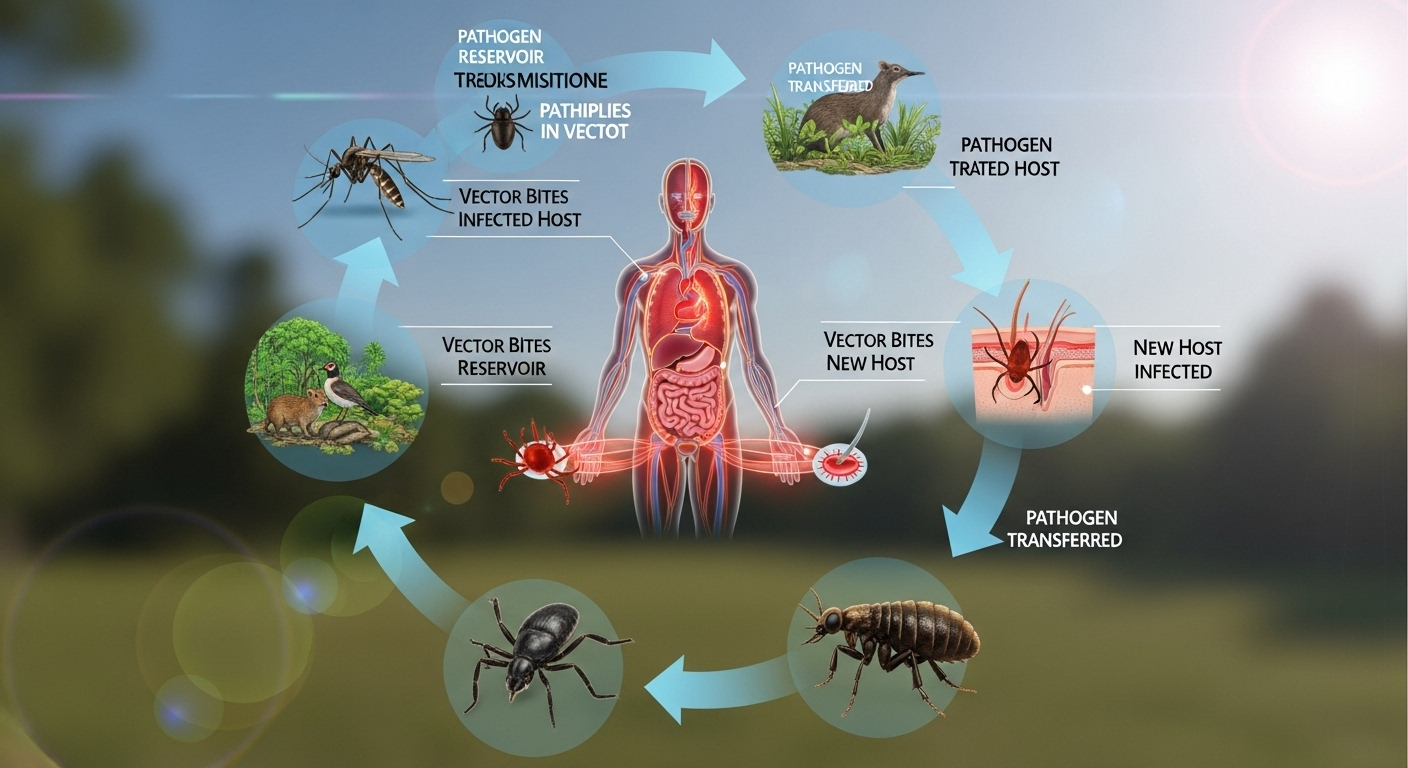What Are Zoonotic Diseases and How Do They Spread?
What Are Zoonotic Diseases and How Do They Spread? Zoonotic diseases are infections that can be transmitted between animals and humans, often causing significant public health challenges. These diseases, which range from mild to life-threatening, originate in animals and can jump to humans through various pathways. Understanding what are zoonotic diseases and how do they spread is crucial for mitigating their impact and preventing outbreaks. From historical pandemics to modern-day epidemics, zoonotic diseases have shaped human history and continue to be a growing concern due to increasing human-animal interaction. This article explores the definition, examples, transmission methods, and prevention strategies of zoonotic diseases, providing a comprehensive overview for readers seeking to grasp their role in global health.
—
Table of Contents
ToggleUnderstanding Zoonotic Diseases: Definitions and Overview
What Are Zoonotic Diseases?
Zoonotic diseases are infections that can be transmitted from animals to humans, often via direct contact, vectors, or environmental factors. These diseases are caused by a wide range of pathogens, including viruses, bacteria, fungi, and parasites, which can affect both wild and domesticated animals. While some zoonotic diseases are well-known, such as rabies and Lyme disease, others remain underreported or misunderstood. The World Health Organization (WHO) defines zoonoses as "infections that are transmitted between species," emphasizing the interconnectedness of human and animal health. By studying these diseases, scientists can identify their origins, hosts, and transmission dynamics, which is essential for developing effective prevention strategies.
The Significance of Zoonotic Diseases
Zoonotic diseases have played a pivotal role in human history, often triggering major health crises and epidemics. For example, the Black Death, which devastated Europe in the 14th century, was caused by the Yersinia pestis bacteria, transmitted through fleas on rats. Similarly, Ebola outbreaks have been linked to wildlife reservoirs like bats, highlighting the need for interdisciplinary research in virology, ecology, and public health. The emergence of zoonotic diseases is often influenced by human activities, such as deforestation, urbanization, and agricultural expansion, which increase contact between humans and animal reservoirs. As the global population grows, the risk of spillover events—where pathogens jump from animals to humans—also rises, making zoonotic disease awareness more critical than ever.
Zoonotic Diseases in the Modern Era
In recent years, zoonotic diseases have become a focal point in global health discussions, especially with the rise of pandemics like COVID-19, which originated in bats. The One Health initiative underscores the importance of collaboration between human, animal, and environmental health sectors to address these challenges. Zoonotic diseases can spread through various ecological and social factors, including climate change, habitat destruction, and globalization, which facilitate rapid transmission across regions. By understanding the biological and environmental drivers behind zoonotic diseases, we can better prepare for future outbreaks and protect vulnerable populations.
—
Common Zoonotic Diseases: Examples and Their Origins
1. Rabies: A Classic Zoonotic Disease
Rabies is one of the most well-known zoonotic diseases, caused by the Rabies virus (Rhabdovirus). This disease is fatal if left untreated but is preventable through vaccination. Rabies spreads primarily through the bite of an infected animal, such as dogs, bats, raccoons, and foxes, which are the main reservoirs of the virus. The disease affects the central nervous system, leading to seizures, paralysis, and death. In many parts of the world, vaccinating pets is a key prevention measure, as dogs are the leading source of human rabies infections. Despite its severity, rabies is preventable with post-exposure prophylaxis, which includes antibodies and vaccines administered after a potential exposure.
2. Lyme Disease: A Vector-Borne Example
Lyme disease is another prominent zoonotic disease, primarily spread by ticks. This illness is caused by the Borrelia bacteria, which resides in ticks and is transmitted to humans through bite. Ticks often feed on deer, mice, and other small mammals, acting as reservoirs for the bacteria. Symptoms of Lyme disease include fever, fatigue, and a skin rash known as erythema migrans, which appears at the site of the bite. If untreated, the disease can progress to joint pain, neurological issues, and heart problems. Prevention strategies involve tick control, personal protection, and early detection. Public health campaigns emphasize safe outdoor practices, such as using repellents and wearing protective clothing, to reduce the risk of infection.
3. Ebola: From Wildlife to Humans
Ebola virus disease is a severe zoonotic infection that has caused multiple outbreaks in Africa, particularly in Central and West African countries. The virus, which is transmitted through bodily fluids, originates in wildlife, with bats being the primary natural hosts. Human infection can occur through direct contact with infected animal blood or bodily fluids, often during hunting or butchering of infected primates or bats. The disease spreads rapidly among humans through close contact with symptomatic individuals, leading to high mortality rates. Ebola outbreaks have highlighted the importance of early intervention and community education, as prevention often involves quarantine measures and vaccination programs. Researchers continue to study animal reservoirs to better understand and contain future outbreaks.
4. Avian Influenza: Bird Flu and Human Health
Avian influenza, commonly known as bird flu, is a zoonotic disease that spreads from birds to humans. Caused by influenza A viruses, it primarily affects poultry and wild birds, which serve as natural reservoirs for the pathogen. Transmission to humans occurs through contact with infected bird secretions, contaminated surfaces, or inhalation of aerosolized particles. While most avian flu strains are mild in humans, certain strains like H5N1 can cause severe illness and high mortality rates. Outbreaks in poultry farms often lead to culling of birds and temporary bans on animal imports. Preventing avian influenza involves monitoring bird populations, implementing biosecurity measures, and vaccinating poultry to reduce the risk of zoonotic transmission.
5. HIV/AIDS: A Modern Zoonotic Pandemic
HIV/AIDS is a zoonotic disease that originated in chimpanzees and crossed into humans through contact with infected blood. The Simian Immunodeficiency Virus (SIV) in chimpanzees is believed to have mutated into HIV during human-animal interactions, such as hunting and butchering of bushmeat. Once in humans, HIV spreads through bodily fluids like blood, semen, and breast milk, primarily through sexual contact, needle sharing, or mother-to-child transmission. The global HIV/AIDS pandemic has had profound social and economic impacts, including loss of life, healthcare costs, and economic productivity. Preventing HIV involves safe sex practices, blood screening, and antiretroviral therapy, which have significantly reduced transmission rates in recent decades.
—
How Zoonotic Diseases Spread: Mechanisms and Pathways
1. Direct Contact Transmission
Direct contact is one of the most common methods of zoonotic disease spread. This occurs when infected animal fluids like blood, saliva, or urine come into contact with human skin or mucous membranes. For example, rabies spreads through bites from infected animals, while HIV can be transmitted via blood-to-blood contact during medical procedures or accidental needle sticks. Direct transmission is often more efficient than indirect methods, as the pathogen enters the human body immediately. Preventing this method involves wearing protective gloves when handling animals and avoiding contact with infected bodily fluids.
2. Vector-Borne Transmission
Vectors are organisms that transmit pathogens between hosts, and they play a critical role in zoonotic disease spread. Mosquitoes, ticks, and fleas are common vectors, with Lyme disease being a classic example. Vectors can carry pathogens from animals to humans through bite or feeding, making vector control essential in preventing outbreaks. Tick-borne diseases like Lyme disease often spread after contact with infected ticks, which feed on small mammals like deer or mice. Mosquito-borne diseases such as malaria or dengue also rely on animal-to-human transmission through vector activity. Understanding vector biology is key to developing targeted prevention strategies, such as insect repellents and mosquito nets.
3. Environmental Contamination Transmission
Environmental contamination is another method by which zoonotic diseases spread. This happens when pathogens are transferred through contaminated surfaces, water, or air. For example, Salmonella can spread via contaminated food or water, often from undercooked meat or raw milk. Environmental factors like poor sanitation or deforestation can increase the risk of zoonotic transmission by bringing humans and animals into closer contact. Hepatitis E and Cryptosporidiosis are also environmentally transmitted zoonotic diseases, often linked to contaminated water sources. Preventing this method requires improved hygiene practices, clean water access, and sanitation infrastructure.
4. Food and Waterborne Transmission
Food and waterborne transmission is a significant route for zoonotic disease spread, particularly in regions with limited access to clean water and proper food handling. Salmonella, E. coli, and Campylobacter are among the common pathogens spread through undercooked meat, contaminated produce, or unpasteurized milk. Waterborne diseases like Cholera or Giardiasis can also originate from infected animal waste entering water supplies. Preventing foodborne transmission involves proper cooking, refrigeration, and hygiene when handling raw animal products. Outbreaks linked to contaminated food or water often highlight the need for stricter food safety regulations and public education on safe consumption practices.

5. Airborne Transmission
Airborne transmission occurs when pathogens spread through respiratory droplets, inhalation of infected particles, or fomites (inanimate objects that carry disease). Tuberculosis, measles, and certain viral infections can spread this way, often from infected animals to humans. For instance, bovine tuberculosis is transmitted through breathing in infected droplets or contact with animal secretions. Airborne zoonotic diseases are particularly challenging to control due to their ability to spread rapidly in crowded environments. Prevention strategies include ventilation, masks, and quarantine to reduce respiratory transmission risks.
—
Preventing Zoonotic Diseases: Strategies for Effective Control
1. Personal Hygiene: A First Line of Defense
Personal hygiene is a simple yet powerful tool in preventing zoonotic diseases. Practicing regular handwashing, avoiding contact with animal feces, and cleaning surfaces regularly can significantly reduce transmission risks. For example, washing hands after handling animals or touching contaminated surfaces is essential in preventing the spread of pathogens. Personal hygiene should also include covering the mouth and nose when coughing or sneezing to minimize airborne transmission. Hygiene education campaigns are crucial in raising awareness about zoonotic risks and preventive measures.
2. Veterinary Care: Protecting Animal and Human Health
Vaccinating pets, livestock, and wildlife is a key strategy in reducing zoonotic disease transmission. Regular veterinary check-ups and health monitoring help identify and manage infections before they spread to humans. For instance, vaccinating dogs against rabies has greatly reduced human cases in many countries. Veterinary care also involves treating infected animals and implementing biosecurity measures in animal farming. Animal health management is integral to One Health initiatives, ensuring sustainable prevention of zoonotic diseases.
3. Public Health Measures: Community-Level Prevention
Public health measures are essential in controlling zoonotic diseases at the community level. These include surveillance systems, education campaigns, and health regulations to reduce transmission risks. Zoonotic disease surveillance allows for early detection of outbreaks and prompt response. For example, surveillance programs in regions affected by avian influenza have helped prevent human infections. Public health campaigns often focus on raising awareness about zoonotic transmission routes and promoting preventive behaviors. Health regulations like animal quarantine and sanitation standards are critical in protecting both humans and animals from pathogens.
4. Vaccination Programs: Targeted Protection
Vaccination programs are one of the most effective ways to prevent zoonotic diseases. By vaccinating high-risk animals, such as dogs and livestock, vaccination creates herd immunity and reduces the likelihood of outbreaks. HIV/AIDS prevention also involves vaccination of at-risk groups, such as healthcare workers or those in close contact with infected animals. Vaccination education is vital in ensuring widespread compliance with immunization schedules. Global vaccination efforts have significantly reduced the incidence of diseases like rabies and measles.
5. Surveillance Systems: Monitoring and Responding to Outbreaks
Surveillance systems are crucial for tracking zoonotic diseases and responding to outbreaks effectively. These systems monitor animal populations, human cases, and environmental factors to identify transmission patterns. Effective surveillance enables data-driven decision-making in public health planning. For instance, global surveillance networks like WHO and CDC have helped coordinate efforts to contain zoonotic outbreaks. Surveillance systems also facilitate research into zoonotic disease origins and transmission dynamics. International collaboration is essential for managing transboundary diseases.
—
The Impact of Zoonotic Diseases: Societal and Economic Consequences
1. Health Implications: A Global Concern
Zoonotic diseases have profound health implications, often leading to acute or chronic illnesses, mortality, and long-term health consequences. These diseases can disrupt healthcare systems and increase the burden on medical resources. For example, Ebola outbreaks have caused high mortality rates and overwhelmed hospitals in affected regions. Health implications also include economic losses, reduced productivity, and increased healthcare costs. Understanding the health effects of zoonotic diseases is critical for developing targeted interventions and public health policies.
2. Economic Impact: Losses and Recovery
The economic impact of zoonotic diseases can be severe, affecting agriculture, trade, and tourism. Outbreaks often lead to loss of livestock, market closures, and reduced food production. For instance, avian influenza outbreaks have resulted in the culling of millions of birds, causing financial losses for farmers and businesses. Zoonotic diseases can also disrupt supply chains and reduce economic activity in affected areas. Recovery efforts require significant investments in healthcare infrastructure and preventive measures. Economic resilience is enhanced through proactive disease management.
3. Global Health Challenges: A Call for Collaboration
Zoonotic diseases pose global health challenges, often spreading across borders and affecting populations worldwide. Climate change, urbanization, and deforestation have increased the risk of zoonotic transmission by bringing humans and animals into closer contact. Global health organizations like WHO and CDC play a key role in monitoring and responding to outbreaks. International collaboration is essential for sharing resources, data, and expertise to combat zoonotic diseases. Global health challenges require sustainable strategies that address both human and animal health.
—
How Zoonotic Diseases Spread: A Comprehensive Overview
1. Direct Contact: The Most Immediate Route
Direct contact is one of the most straightforward methods by which zoonotic diseases spread. This occurs when infected bodily fluids (e.g., blood, saliva, or urine) come into contact with human skin or mucous membranes. Rabies spreads through bites from infected animals, while HIV can be transmitted via blood-to-blood contact during medical procedures or accidental exposure. Direct transmission is often efficient and rapid, requiring close proximity between species. Preventing direct contact involves wearing gloves when handling animals, avoiding scratches or bites, and cleaning contaminated surfaces promptly.
2. Vectors: Mediators of Disease Transmission
Vectors act as carriers of pathogens between animals and humans, playing a crucial role in zoonotic spread. Mosquitoes, ticks, and fleas are common vectors, with Lyme disease being a classic example. Tick-borne diseases often spread after contact with infected ticks, which feed on small mammals like deer or mice. Mosquitoes are responsible for spreading diseases such as malaria and dengue, which can transition from animal to human hosts. Vector control programs involve insecticides, repellents, and habitat modification to reduce the risk of transmission. Understanding vector behavior is key to developing effective prevention strategies.
3. Environmental Contamination: A Hidden Threat
Environmental contamination is a less obvious but significant method of zoonotic disease spread. This occurs when pathogens are present in the environment and transmitted through contact with contaminated surfaces or water. Salmonella and E. coli are commonly spread through contaminated food or water, often from undercooked meat or unpasteurized dairy products. Hepatitis E and Cryptosporidiosis can also spread through water sources. Improving sanitation and hygiene practices is crucial in reducing environmental transmission. Environmental factors such as poor waste management and unprotected water supplies can amplify the spread of zoonotic diseases.
4. Food and Waterborne Transmission: A Global Risk
Food and waterborne transmission is a critical route for zoonotic diseases, especially in regions with limited access to clean water. Contaminated food or water can carry pathogens like Salmonella, E. coli, and Campylobacter, which are often present in animal products. Outbreaks linked to contaminated produce or dairy highlight the importance of food safety standards and hygiene education. Waterborne diseases such as Cholera and Giardiasis can originate from animal waste entering water supplies. **Preventing food













